gguy44/iStock via Getty Images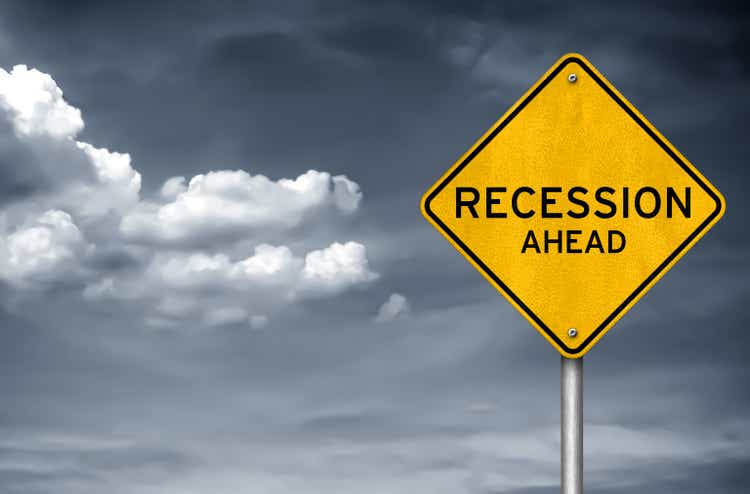
What Causes The Recurring Boom & Bust Business Cycle?
More than a century ago, Austrian economist Ludwig von Mises developed a theory of the business cycle, which I believe explains the recurring “boom and bust” cycle more accurately than any other economic theory. Mises’ student, F.A. Hayek, won the 1974 Nobel Prize in economics for his work on this theory, which is now known as Austrian Business Cycle Theory.
The basic outline of Austrian Business Cycle Theory is as follows:
- the government central bank (in the US, it is the Federal Reserve or “Fed”) creates money out of thin air, usually by buying Treasury bills or bonds from commercial banks, which then…
- is deposited in commercial banks which, through the process of fractional reserve banking (where banks are allowed to keep only a fraction, such as 10%, of their deposits in cash reserves), create more money out of thin air to lend to their customers, which then…
- leads to lower interest rates than would prevail in a free market without banks creating money out of thin air, which then…
- causes businesses and consumers to borrow the newly created money to invest in long-term projects such as mines, factories, houses, etc., since the profitability of those investments appears higher now with a lower cost of capital, which then…
- leads to the unsustainable “boom” phase of the business cycle where scarce capital is misallocated to unsustainable investments since the real resources of raw materials, equipment and labor needed to finish these long-term projects are not physically available; then…
- the higher money supply leads to higher price inflation, which raises production costs and usually causes the central bank to slow the growth rate of money supply and raise interest rates to try to lower inflation (if they do not, it will eventually lead to hyperinflation, which can destroy a functioning currency and economy), which then…
- leads to the “bust” phase of the business cycle, where the unsustainable investments are proven to be unprofitable and must be liquidated to allocate capital to the most productive uses that meet consumer desires.
According to this theory, the dreaded boom and bust business cycle is not inherent in a free market economy. It is set in motion by central and commercial banks creating money out of thin air. As Mises summarized:
“True, governments can reduce the rate of interest in the short run. They can issue additional paper money. They can open the way to credit expansion by the banks. They can thus create an artificial boom and the appearance of prosperity. But such a boom is bound to collapse soon or late and to bring about a depression.”
Money Supply Increased By Nearly 40% in 2020
As a result of the stock market crash and global economic collapse caused by the covid pandemic in early 2020, the Fed aggressively increased the money supply by nearly 40%, more than double the money supply increases in prior recessions, as shown below (which is the “Austrian Money Supply”, calculated as M2 less Small Time Deposits and Retail Money Market Funds plus Treasury Deposits at the Fed).
Austrian Money Supply growth (FRED)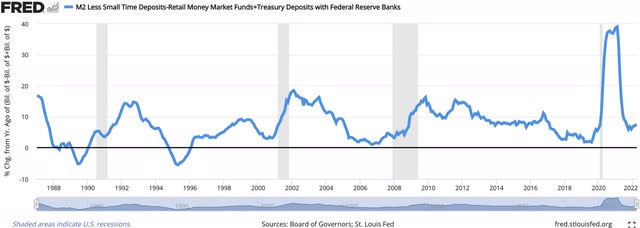
I believe this money creation contributed to the highest inflation rates in over 40 years, with the latest CPI report showing inflation at 8.6%, well above the Fed’s 2% target. And now that money supply growth has slowed substantially to only 7% -and the Fed-controlled Monetary Base (currency plus bank reserves at the Fed) is declining 2.6% year-over-year – the economy is starting to slow.
Recession Signs Are Mounting…
Economic growth has already weakened substantially. US GDP fell -1.4% in the first quarter of 2022 and the Atlanta Fed is now estimating 0% GDP growth in the second quarter.
Real Personal Income is down -3.5% year-over-year, and was down 17% in March, the biggest decline in over 60 years. Real Manufacturing and Trade Sales are now down -2.5% year-over-year. This broad sales measure only declines in recessionary periods, as shown below (recessionary periods are shaded gray).
Real Manufacturing & Trade Sales (FRED)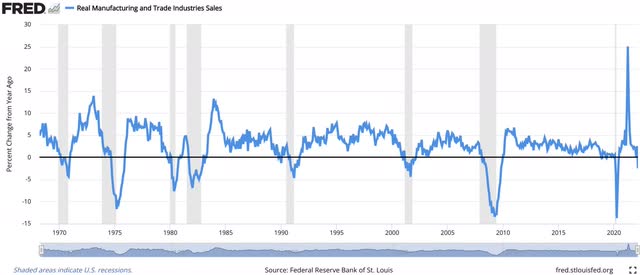
Interest rates have been skyrocketing due to high inflation and slower money supply growth. The 10-Year Treasury yield increased from 1.19% last summer to 3.25% now, while the 2-Year Treasury yield increased from 0.13% last summer to 3.17% now. The 30-Year Fixed Mortgage rate has risen from 2.77% last summer to 5.78% now, which is causing a collapse in mortgage applications and homebuilder sentiment.
The “yield curve” spread between the 10-Year and 2-Year Treasury yields has now flattened to only 0.08%. This spread “inverted” briefly a couple of months ago when the 2-Year yield rose above the 10-Year yield. It could easily invert again soon. As shown below, a flattish or inverted yield curve spread between the 10-Year and 2-Year Treasury yields has occurred before every recession in recent decades.
Yield Curve Spread 2-Year less 10-Year (FRED)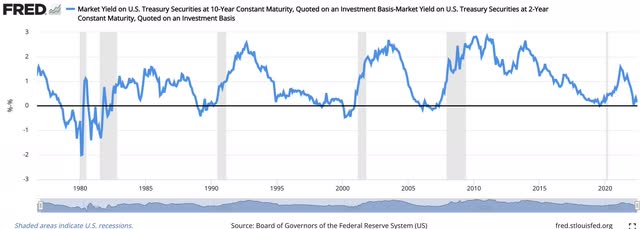
The spread between high yield “junk” corporate bonds and Treasury yields has risen to the highest levels since the covid panic of 2020, as junk bond investors appear to be pricing in the risk of a recession, as shown below.
High Yield Corporate Bond Spread (StockCharts.com)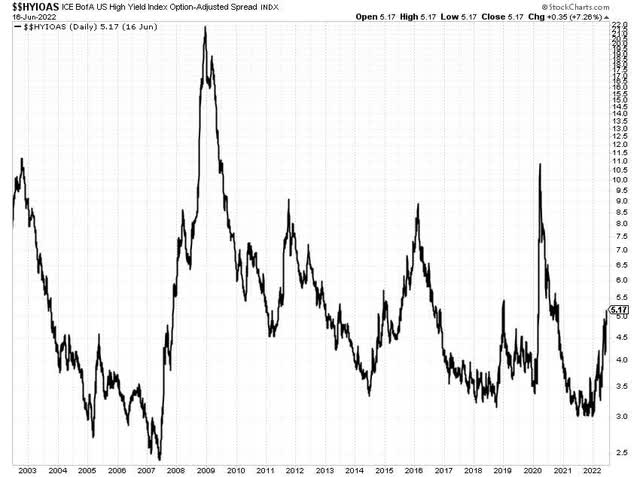
Copper is a commodity that historically is very sensitive to business cycle fluctuations. In fact, it is often called “Dr. Copper” by economists, since it can serve as a useful indicator of the direction of the economy. Copper prices have fallen 20% in the past three months, which is not encouraging.
Initial unemployment claims are considered to be one of the best leading indicators of employment. They have been rising steadily for the past three months, as shown below (weekly claims are the black line and the four-week moving average is the red line).
Initial Unemployment Claims (StockCharts.com)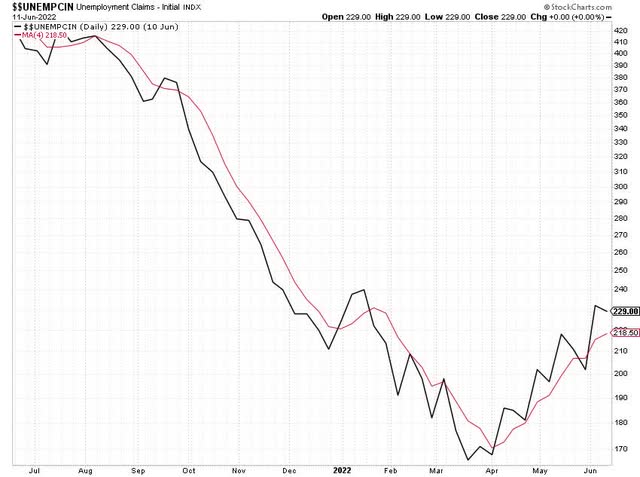
The University of Michigan Consumer Sentiment survey has fallen to the lowest levels in over 40 years, as shown below.
Univ. of Michigan Consumer Sentiment (StockCharts.com)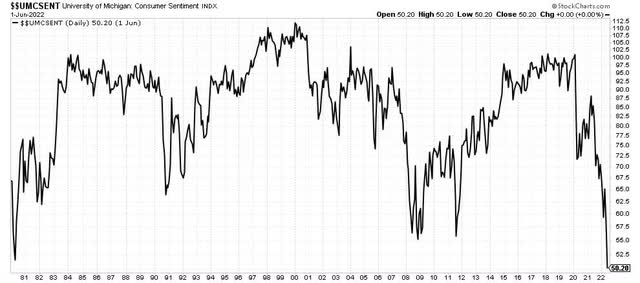
Similarly, The Conference Board CEO Confidence survey has fallen to recessionary levels, as shown below.
CEO Confidence (The Conference Board)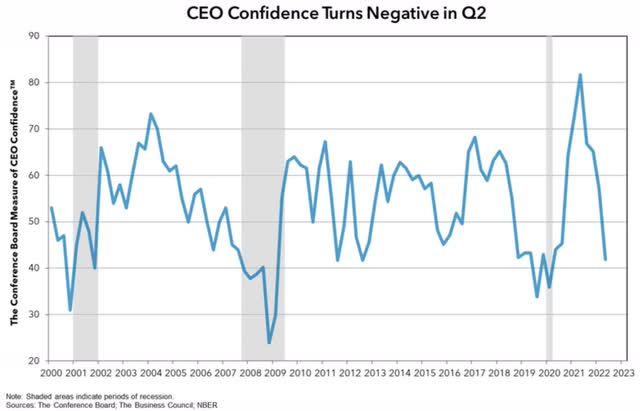
Proven leading economic indices have fallen to recessionary levels. The Economic Cycle Research Institute’s Weekly Leading Index, which leads the US economy by at least six months, has declined from a high of around +28% last year to -6.3% now. This highly regarded economic forecasting firm has recently gone public with their forecast for a coming recession.
The Brave-Butters-Kelley Leading Index has fallen well below the -1 threshold that signals with 86% accuracy that a recession is likely to start within eight months, as shown below.
Brave-Butters-Kelley Leading Index (FRED)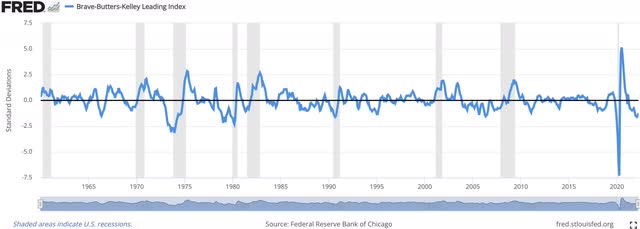
…As The Fed Tries To Tighten Financial Conditions To Lower Inflation
I believe the Fed would normally be slashing interest rates and creating new money to try to prevent a recession and stock bear market at this point, as they tried to do in the early 2000s Tech Bust and 2009-2009 Great Recession.
But instead, the Fed is hiking interest rates aggressively to try to bring inflation down. They already hiked the Fed Funds rate to 1.50% to 1.75% and may raise it at least 1.50% more to catch up to the current 2-Year Treasury yield.
Bill Dudley, former president of the New York Fed and Vice Chairman of the Fed’s Federal Open Market Committee, has said in recent months that the Fed wants tighten financial conditions – which includes lowering bond and stock prices – to try to lower inflation:
“The Fed’s application of its framework has left it behind the curve in controlling inflation. This, in turn, has made a hard landing virtually inevitable…To create sufficient economic slack to restrain inflation, the Fed will have to tighten enough to push the unemployment rate higher…Getting inflation down will be costly, in terms of jobs and economic growth…Investors should pay closer attention to what Powell has said: Financial conditions need to tighten. If this doesn’t happen on its own (which seems unlikely), the Fed will have to shock markets to achieve the desired response. This would mean hiking the federal funds rate considerably higher than currently anticipated. One way or another, to get inflation under control, the Fed will need to push bond yields higher and stock prices lower…So far, financial conditions really haven’t tightened very much…The Fed has to push up the unemployment rate, when the Fed has done that in the past, it has always resulted in a recession…It is very unlikely that a year from now we will be at this level of bond yields this low and this level of stock prices this high.”
As shown below, despite the current stock and bond bear markets, financial conditions remain relatively loose on a historical basis, according to the Chicago Fed National Financial Conditions Index.
National Financial Conditions Index (FRED)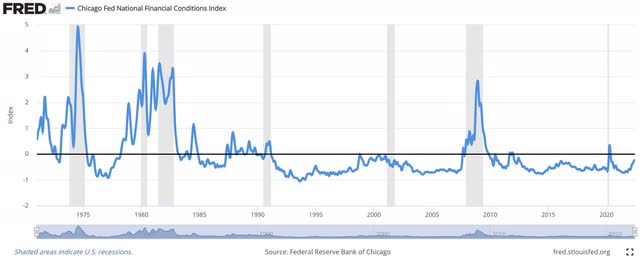
Implications For Investors
If the Fed succeeds in tightening financial conditions enough to lower inflation, I believe this could lead to the biggest recession and stock bear market since the Great Depression, as I predicted in this Seeking Alpha article last summer.
So it is important for investors to understand how to identify bull and bear market trends to determine when this bear market ends and a new bull market begins, as I explained in this Seeking Alpha article.
In the meantime, as this recession I see coming intensifies and lowers stock prices further, investors can profit from this bear market using inverse (“short)” ETFs, as I discussed in this Seeking Alpha article, such as the ProShares Short S&P 500 (SH) and ProShares UltraShort (2x) S&P 500 (SDS) ETFs. SH and SDS have Seeking Alpha Quant Ratings of 4.64 and 4.75, respectively, which are “Strong Buy” ratings.


Be the first to comment